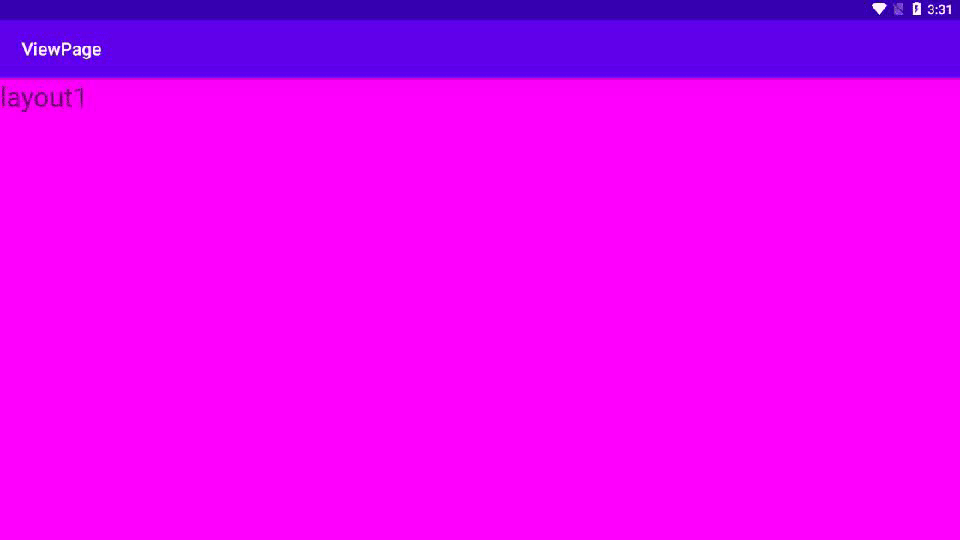3.ViewPager
ViewPager是什么东西

主界面
<?xml version="1.0" encoding="utf-8"?> <LinearLayout xmlns:android="http://schemas.android.com/apk/res/android" xmlns:app="http://schemas.android.com/apk/res-auto" xmlns:tools="http://schemas.android.com/tools" android:layout_width="match_parent" android:layout_height="match_parent" android:background="#ff00ff" tools:context=".MainActivity"> <androidx.viewpager.widget.ViewPager android:id="@+id/myViewPage" android:layout_width="match_parent" android:layout_height="match_parent" /> LinearLayout>
layout1
<?xml version="1.0" encoding="utf-8"?> <LinearLayout xmlns:android="http://schemas.android.com/apk/res/android" xmlns:app="http://schemas.android.com/apk/res-auto" xmlns:tools="http://schemas.android.com/tools" android:layout_width="match_parent" android:layout_height="match_parent" android:background="#ff00ff" tools:context=".MainActivity"> <TextView android:layout_width="wrap_content" android:layout_height="wrap_content" android:text="layout1" android:textSize="30sp" /> LinearLayout>
layout2
<?xml version="1.0" encoding="utf-8"?> <LinearLayout xmlns:android="http://schemas.android.com/apk/res/android" xmlns:app="http://schemas.android.com/apk/res-auto" xmlns:tools="http://schemas.android.com/tools" android:layout_width="match_parent" android:layout_height="match_parent" android:background="#ff0f0f" tools:context=".MainActivity"> <TextView android:layout_width="wrap_content" android:layout_height="wrap_content" android:text="layout2" android:textSize="30sp" /> LinearLayout>
layout3
<?xml version="1.0" encoding="utf-8"?> <LinearLayout xmlns:android="http://schemas.android.com/apk/res/android" xmlns:app="http://schemas.android.com/apk/res-auto" xmlns:tools="http://schemas.android.com/tools" android:layout_width="match_parent" android:layout_height="match_parent" android:background="#0000ff" tools:context=".MainActivity"> <TextView android:layout_width="wrap_content" android:layout_height="wrap_content" android:text="layout3" android:textSize="30sp" /> LinearLayout>
适配器 MyAdaper.class
package com.example.viewpage; import android.view.View; import android.view.ViewGroup; import androidx.annotation.NonNull; import androidx.viewpager.widget.PagerAdapter; import java.util.List; public class MyAdapter extends PagerAdapter { private List myList; //建一个构造方法,用于放数据 public MyAdapter(List myList) { this.myList = myList; } @Override public int getCount() { return myList.size(); } //instantiate实例化的意思 //在容器中放页面,然后返回 @NonNull @Override public Object instantiateItem(@NonNull ViewGroup container, int position) { container.addView(myList.get(position),0); return myList.get(position); } @Override public boolean isViewFromObject(@NonNull View view, @NonNull Object object) { return view == object; } @Override public void destroyItem(@NonNull ViewGroup container, int position, @NonNull Object object) { container.removeView(myList.get(position)); } }
MainACtivity.claspackage com.example.viewpage;
import androidx.appcompat.app.AppCompatActivity; import androidx.viewpager.widget.ViewPager; import android.os.Bundle; import android.view.LayoutInflater; import android.view.View; import java.util.ArrayList; import java.util.List; public class MainActivity extends AppCompatActivity { @Override protected void onCreate(Bundle savedInstanceState) { super.onCreate(savedInstanceState); setContentView(R.layout.activity_main); //把页面渲染出来,然后存到集合里
//LayoutInflater是一个用于将xml布局文件加载为View或者ViewGroup对象的工具,我们可以称之为布局加载器
LayoutInflater lf = getLayoutInflater().from(this); View view1 = lf.inflate(R.layout.layout1,null); View view2 = lf.inflate(R.layout.layout2,null); View view3 = lf.inflate(R.layout.layout3,null); List myList = new ArrayList<>(); myList.add(view1); myList.add(view2); myList.add(view3); ViewPager viewPager = findViewById(R.id.myViewPage); MyAdapter myAdapter = new MyAdapter(myList); viewPager.setAdapter(myAdapter); } }
有关函数解析:
ViewPager里面对每个页面的管理是key-value形式的,也就是说每个page都有个对应的id(id是object类型),需要对page操作的时候都是通过id来完成的
首先看这个函数
public Object instantiateItem(ViewGroup container, int position);
这是pageAdapter里的函数,功能就是往PageView里添加自己需要的page。同时注意它还有个返回值object,这就是那个id。
最后
public abstract boolean isViewFromObject (View view, Object object)
这个函数就是用来告诉框架,这个view的id是不是这个object。
谷歌官方推荐把view当id用,所以常规的instantiateItem()函数的返回值是你自己定义的view,而isViewFromObject()的返回值是view == object。
ps:感觉这个机制应该是历史遗留问题,属于改bug改出来的机制。否则官方不会推荐这种把view当id的做法。






 浙公网安备 33010602011771号
浙公网安备 33010602011771号